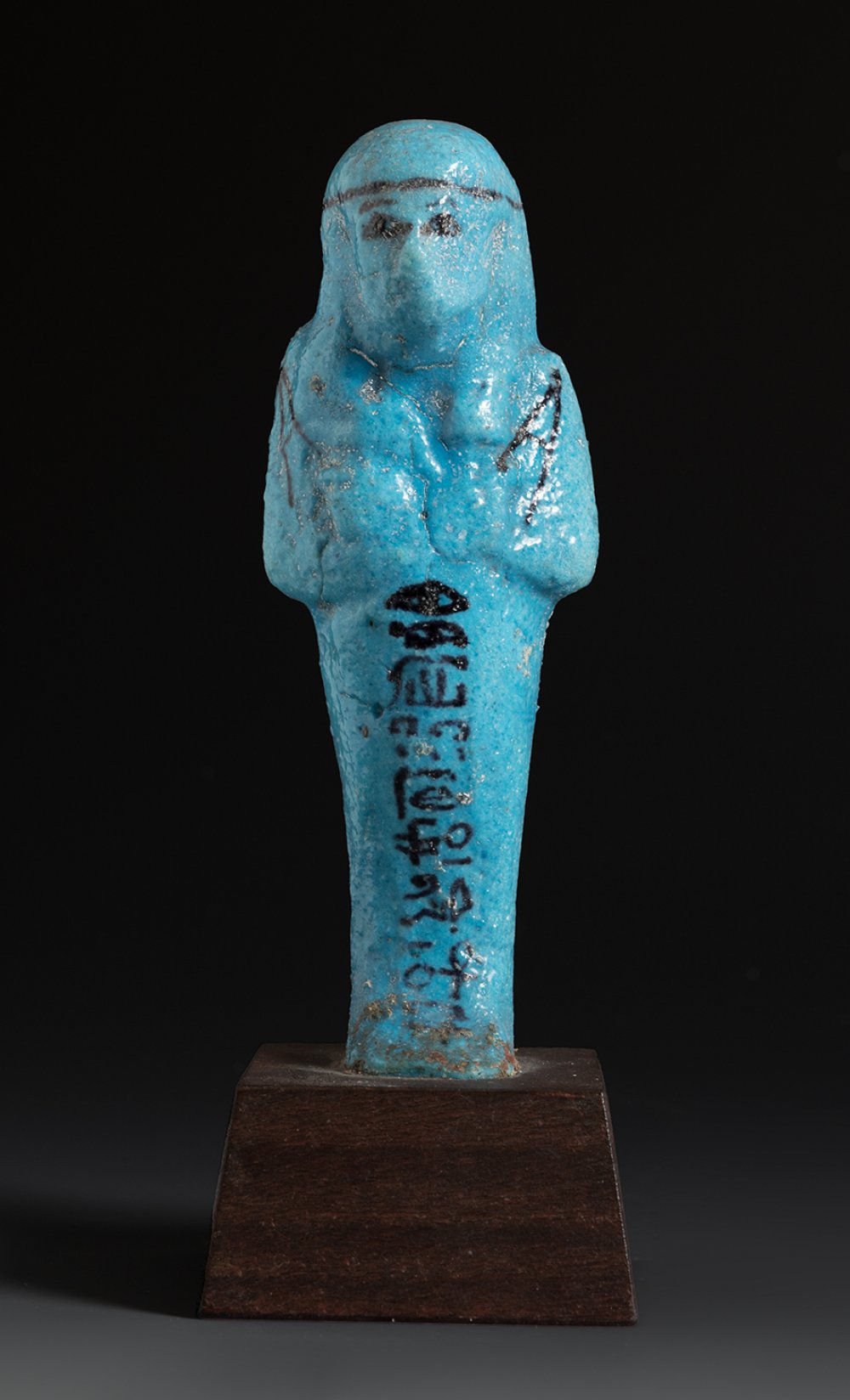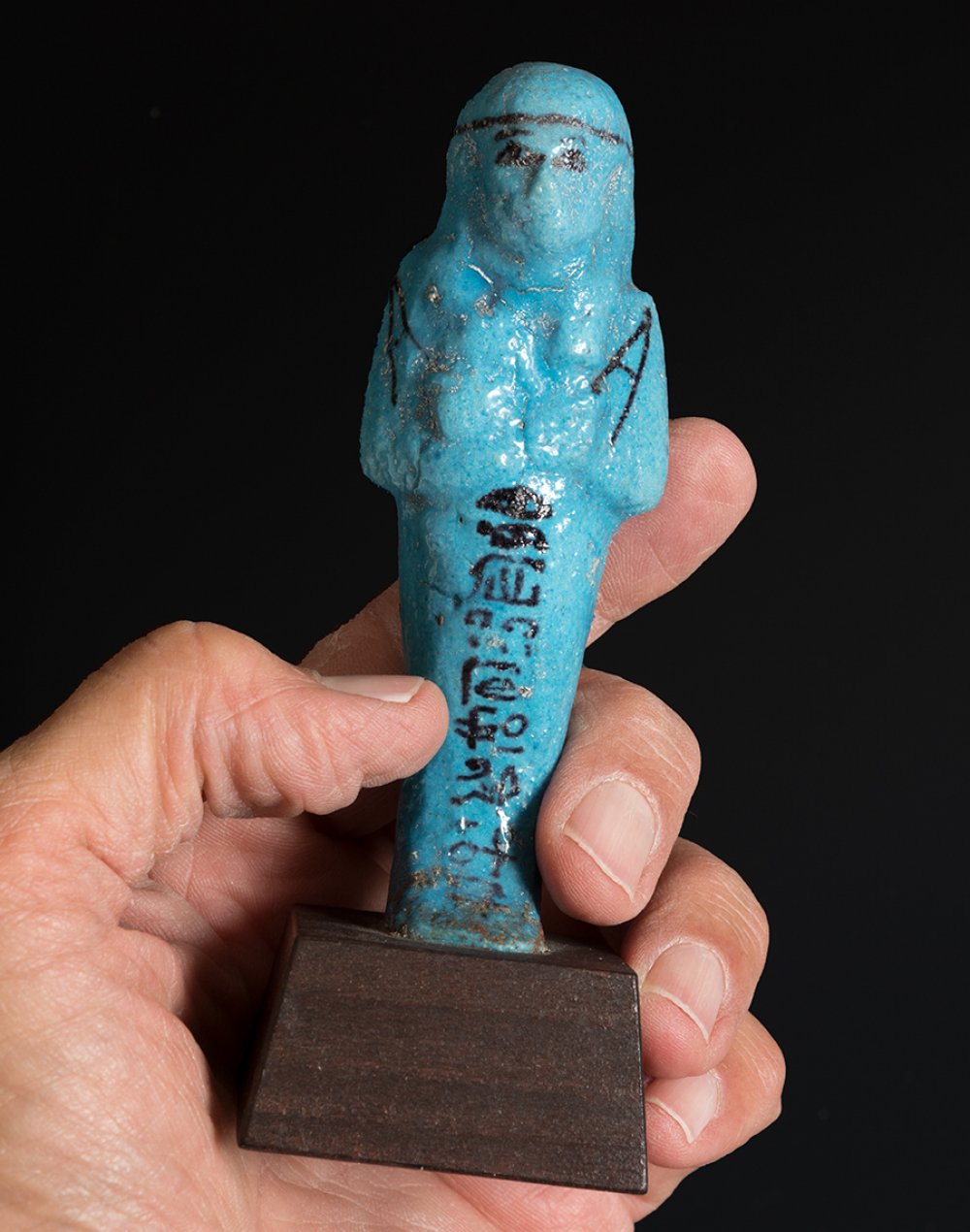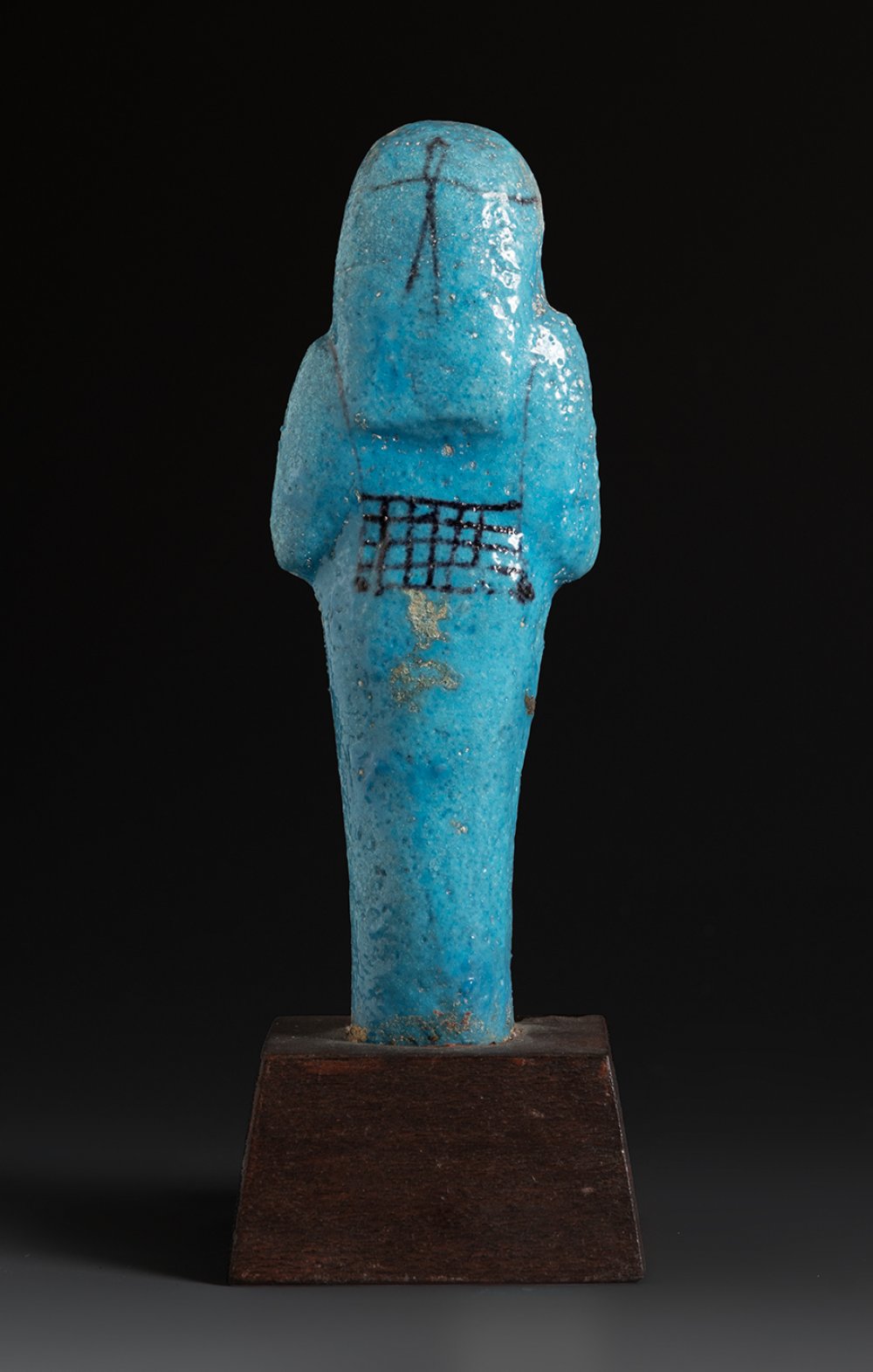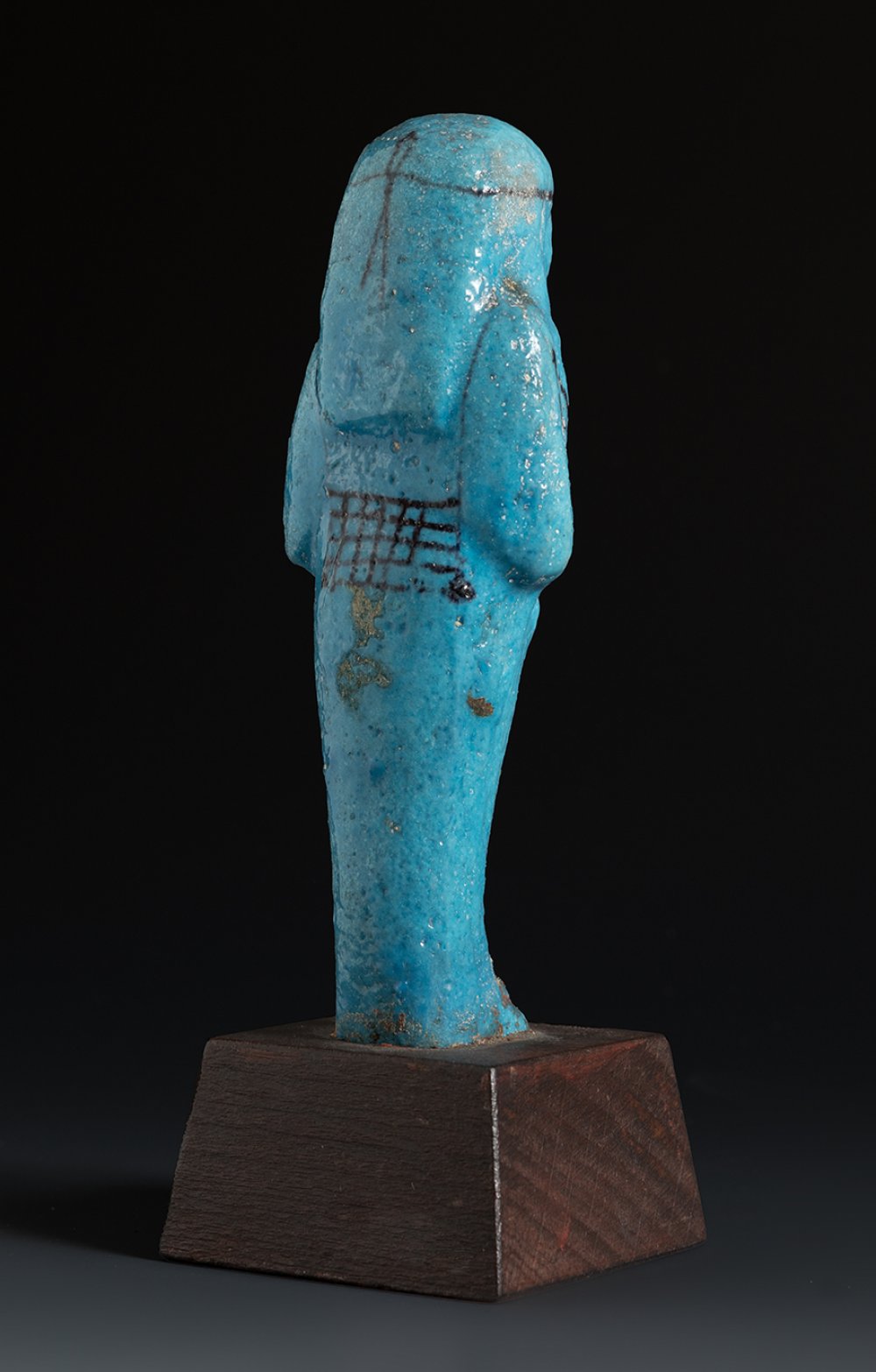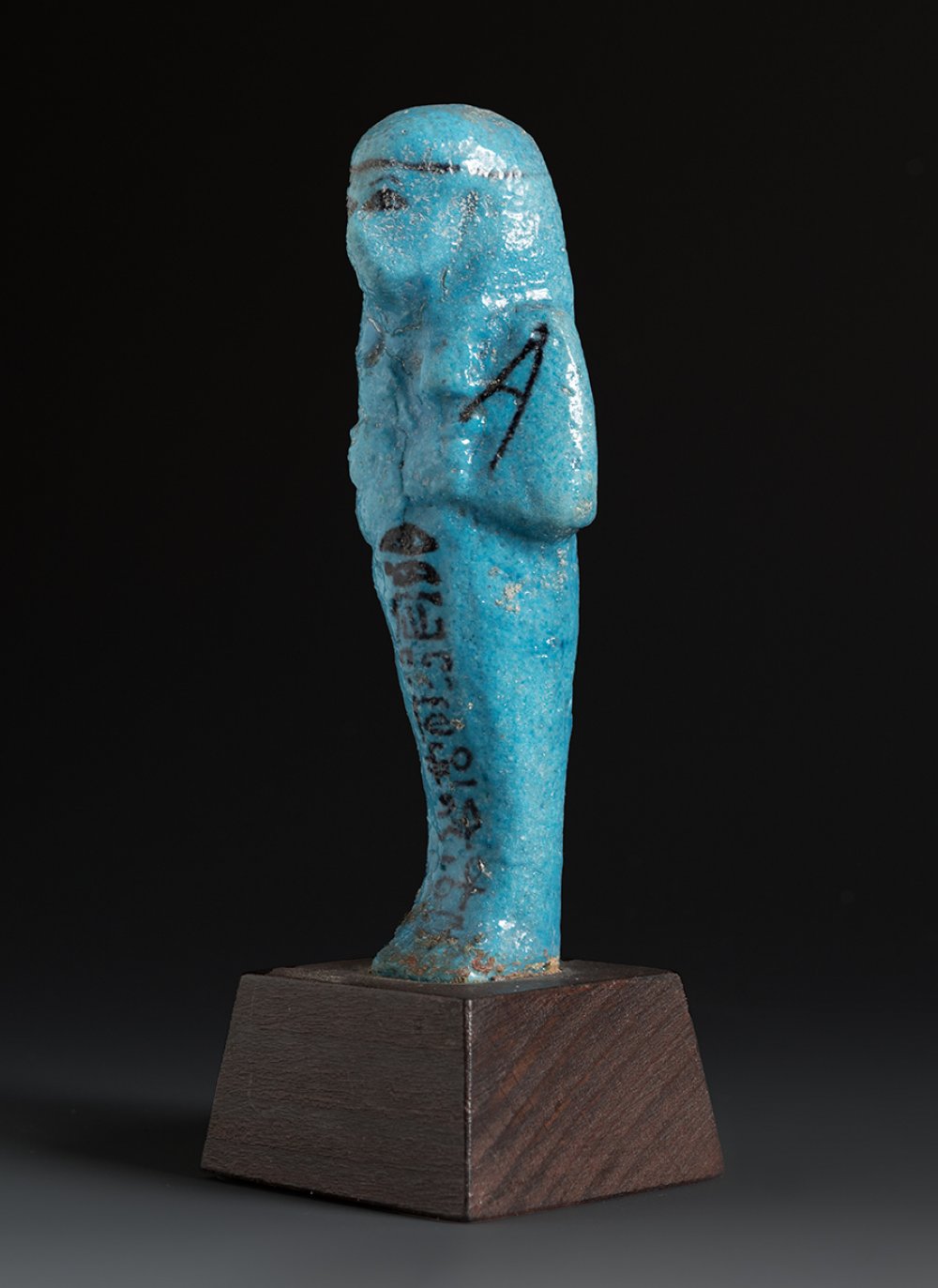17
Ushebti for the Overseer of the Granaries, Djedkhonsu-iwf-ankh. Ancient Egypt, Deir el Bahar,
Fayyza.
Provenance: Private collection, France, 1970 - 1980. Excavated by Herbert Winlock at Deir el-Bahri.
The hieroglyphic text column translates as: "The Osiris, overseer of granaries, Djedkhonsu-iwf-ankh, justified."
Intact.
Measurements: 10.5 cm (ushebti); 13 cm (height with stand).
Made of faience, this ushebti is in the form of a standing human figure, with the features and other details highlighted in black. She wears the typical Egyptian tripartite wig held in place with a ribbon, and is wrapped in a shroud that leaves her arms out, crossing them over her chest and holding emblems of power in her hands. On the belly and legs is written in hieroglyphs a text that would translate as 'The Osiris, overseer of granaries, Djedkhonsu-iwf-ankh, justified'. The ushebtis, an Egyptian term meaning 'those who answer', are small statuettes which, in ancient Egypt, were placed in tombs as part of the grave goods of the deceased, and whose function was to replace him in the work he had to carry out in the Afterlife. The ushabties placed in the grave goods consisted of 365 figurines, one for each day of the year. In addition, 36 foremen could be added, who commanded each of the crews composed of 10 workers. Most were made of ceramic, wood or stone, although in the richest tombs they could be found carved in lapis lazuli. The oldest surviving examples come from the Middle Kingdom, although there are references to them in texts from the end of the Early Empire. After the sacred scarabs, ushebtis are the most numerous and possibly the most characteristic pieces of Egyptian art that have survived to the present day. Throughout the ages they have always had the same function in the religious sphere, but while during the Middle Kingdom they were conceived as a representation of their owner before Osiris in the work of tillage in the kingdom of the shadows, replicas of the deceased, from the New Kingdom onwards they came to be seen as his servants or slaves, and were made in large quantities. Faience is a ceramic material with a vitreous finish that was widely used in Ancient Egypt to make small statues, amulets, etc. because its chromatic range could imitate more expensive stones such as lapis lazuli.
Fayyza.
Provenance: Private collection, France, 1970 - 1980. Excavated by Herbert Winlock at Deir el-Bahri.
The hieroglyphic text column translates as: "The Osiris, overseer of granaries, Djedkhonsu-iwf-ankh, justified."
Intact.
Measurements: 10.5 cm (ushebti); 13 cm (height with stand).
Made of faience, this ushebti is in the form of a standing human figure, with the features and other details highlighted in black. She wears the typical Egyptian tripartite wig held in place with a ribbon, and is wrapped in a shroud that leaves her arms out, crossing them over her chest and holding emblems of power in her hands. On the belly and legs is written in hieroglyphs a text that would translate as 'The Osiris, overseer of granaries, Djedkhonsu-iwf-ankh, justified'. The ushebtis, an Egyptian term meaning 'those who answer', are small statuettes which, in ancient Egypt, were placed in tombs as part of the grave goods of the deceased, and whose function was to replace him in the work he had to carry out in the Afterlife. The ushabties placed in the grave goods consisted of 365 figurines, one for each day of the year. In addition, 36 foremen could be added, who commanded each of the crews composed of 10 workers. Most were made of ceramic, wood or stone, although in the richest tombs they could be found carved in lapis lazuli. The oldest surviving examples come from the Middle Kingdom, although there are references to them in texts from the end of the Early Empire. After the sacred scarabs, ushebtis are the most numerous and possibly the most characteristic pieces of Egyptian art that have survived to the present day. Throughout the ages they have always had the same function in the religious sphere, but while during the Middle Kingdom they were conceived as a representation of their owner before Osiris in the work of tillage in the kingdom of the shadows, replicas of the deceased, from the New Kingdom onwards they came to be seen as his servants or slaves, and were made in large quantities. Faience is a ceramic material with a vitreous finish that was widely used in Ancient Egypt to make small statues, amulets, etc. because its chromatic range could imitate more expensive stones such as lapis lazuli.
29th September - Archaeology
Sale Date(s)
Venue Address
General delivery information available from the auctioneer
Setdart offers Worldwide shipping
PICK UP IN ROOM: You can come and pick up your lots in our offices (Barcelona, Madrid or Valencia). At the moment of the withdrawal, you will be able to accept the current conditions of the lot by means of a document that you will sign.
YOU CAN SEND ANOTHER PERSON TO PICK UP: This person must present a signed authorization that you can find in our web page by accessing from BUY AT SETDART- LOGISTICS-DOWNLOAD AUTHORIZATION DOCUMENT. You can also send an e-mail with the requested data in AUTHORIZATION DOCUMENT to admin@setdart.com
Important Information
25% buyer´s premium
21% buyer´s premium at www.setdart.com
Terms & Conditions
The maximum period to pay the lots is 7 working days. You can pay either via bank transfer or with credit card through our platform www.setdart.com (we only accept VISA or Mastercard).
BUYER´S PREMIUM: 22% Hammer price + 21% VAT from the buyer´s premium
If your piece has more than 100 years, our Ministry of Culture requires an export certificate in order for the piece to leave the country. Note that if the piece goes inside the EU, there is no cost for the export certificate. If the piece goes outside the EU, there is a cost for the export certificate. You can find more information in our Ministry of Culture website: https://www.culturaydeporte.gob.es/en/cultura/patrimonio/exportacionimportacion/exportacion/tasas.html
INQUIRIES: admin@setdart.com
Setdart guides you through the entire process, from the time of award to the day you receive your lot. Our logistics team will be happy to manage your transport, and will advise you on the best shipping method with professionals from the sector used to handling works of art and jewelry.
WE OFFER WORLDWIDE DOOR TO DOOR SHIPPING
PICK UP IN ROOM: You can come and pick up your lots in our offices. At the moment of the withdrawal, you will be able to accept the current conditions of the lot by means of a document that you will sign.
YOU CAN SEND ANOTHER PERSON TO PICK UP: This person must present a signed authorization that you can find in our web page by accessing from BUY AT SETDART-LOGISTICS-DOWNLOAD AUTHORIZATION DOCUMENT. You can also send an e-mail with the requested data in AUTHORIZATION DOCUMENT to admin@setdart.com
SETDART IS NOT RESPONSIBLE FOR THE STATE OF THE PARTS ONCE THEY LEAVE OUR FACILITIES. MRW SHIPMENTS: Once the payment is made, your lot will be packed for shipment, the logistics department will send you an e-mail notifying you of the day it leaves our warehouse, changes of address cannot be made after receiving this e-mail.
INSURANCE INCIDENTS: Coverage for the value of the auction up to 3000 ? per shipment, if the value of the auction is higher, Setdart will send you a quote including the additional insurance. The insurance company WILL NOT BE RESPONSIBLE FOR THE SHIPMENT THAT EXCEEDS THAT AMOUNT AND IS NOT FULLY INSURED. MRW INCIDENTS: Maximum notification 48 hours after receipt, after which the insurance company WILL NOT BE RESPONSIBLE AND NO CLAIMS WILL BE ACCEPTED.
E-MAIL LOGISTICS: logistica@setdart.com
PICK UP YOUR MESSAGES: You can send your own messaging, prior notice via e-mail that your shipment is ready, please note 3 or 4 days in advance. This type of shipment is packaged so Setdart will provide you with a quote.
EXPENSES FOR STORAGE: We inform you that if the purchased lot is not picked up within a month, you will be charged 30€ per week per lot. Setdart Online S.L., owner of the web site "setdart.com", "setdart.net" and "setdart.org", acts as a company of Spanish nationality inscribed in the Volume 36955, sheet 182, page B-293056 of the Mercantile Registry, with registered office at Calle Aragó











